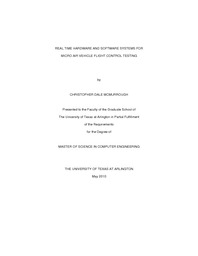| dc.contributor.author | McMurrough, Christopher Dale | en_US |
| dc.date.accessioned | 2010-07-19T19:54:39Z | |
| dc.date.available | 2010-07-19T19:54:39Z | |
| dc.date.issued | 2010-07-19 | |
| dc.date.submitted | January 2010 | en_US |
| dc.identifier.other | DISS-10611 | en_US |
| dc.identifier.uri | http://hdl.handle.net/10106/4891 | |
| dc.description.abstract | The trend of increasing capabilities of micro scale electrical, mechanical, and computing systems is opening up the possibilities of new unmanned vehicle platforms. Both unmanned aerial and ground vehicles have traditionally been created from large conventional platforms such as automobiles, rotorcraft, and fixed wing aircraft. These conventional chassis designs are durable and proven, but the benefits of automating these types of platforms are limited by their inherent human-centric design. Many real-world applications would benefit greatly from vehicle classes designed with unconventional means such as biologically inspired locomotion. Micro air vehicles are a class of vehicles that have recently began moving from the realm of the probable to that of the practical. Current micro aerial vehicle (MAV) designs are generally nothing more than scaled down fixed wing airplanes or rotorcraft, but biologically inspired flapping wing platforms at the insect scale are now a distinct possibility. Flapping wing MAVs have the potential to perform tasks in environments that conventional aerial vehicles fail due to constraints imposed by size and weight, robustness to environmental perturbations, and endurance. Flapping wing MAV development requires new experimentation techniques for control design and validation. These types of vehicles require rapid actuator responses to a degree where human remote control is impossible without electronic assistance. This and other caveats make it difficult to develop MAV platforms and controllers without complete avionics and power systems, which are in turn difficult to develop when the vehicle specifications are unknown. In this thesis, a Real-Time Testing Environment for Development of MAV Flight Controls is presented. The system makes it possible to test MAV flight controls without integrated avionics by using real-time computing hardware within a vision based motion capture environment. A Split-Cycle Wingbeat Modulated MAV Platform for Hardware-in-the-loop Control Analysis is also presented. This test platform was designed and fabricated to verify the motion capabilities of a proposed flapping MAV controller on a practical vehicle. The vehicle platform is actuated by brushless DC motors (BLDC) and controlled by real-time computing hardware. The instantaneous forces and torques generated by the vehicle are measured with a 6 DOF force/torque transducer for processing by the real-time computer. Finally, A Reinforcement Learning Approach to BLDC Motor Commutation is also proposed in the context of actuating a flapping wing with finite timing constraints. This approach involves the use of a Q-learning algorithm to learn the optimal amount of power to apply at a given motor commutation state to achieve a desired transition time. | en_US |
| dc.description.sponsorship | Lewis, Frank | en_US |
| dc.language.iso | EN | en_US |
| dc.publisher | Computer Science & Engineering | en_US |
| dc.title | Real Time Hardware And Software Systems For Micro Air Vehicle Flight Control Testing | en_US |
| dc.type | M.S. | en_US |
| dc.contributor.committeeChair | Lewis, Frank | en_US |
| dc.degree.department | Computer Science & Engineering | en_US |
| dc.degree.discipline | Computer Science & Engineering | en_US |
| dc.degree.grantor | University of Texas at Arlington | en_US |
| dc.degree.level | masters | en_US |
| dc.degree.name | M.S. | en_US |
| dc.identifier.externalLink | https://www.uta.edu/ra/real/editprofile.php?onlyview=1&pid=27 | |
| dc.identifier.externalLinkDescription | Link to Research Profiles | |

